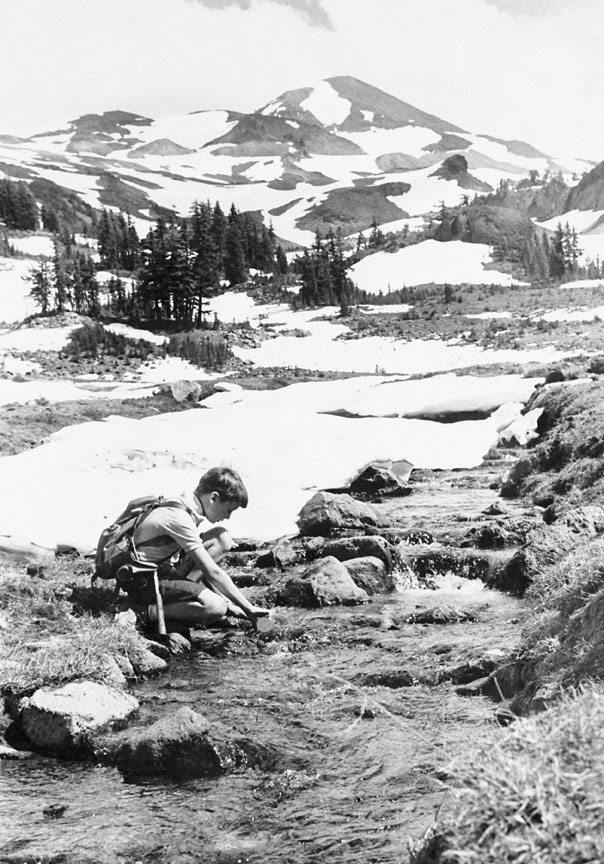- Catalog No. —
- CN 015329
- Date —
- c. 1968
- Era —
- 1950-1980 (New Economy, Civil Rights, and Environmentalism)
- Themes —
- Environment and Natural Resources
- Credits —
- Oregon Historical Society
- Regions —
- Cascades Central
- Author —
- Oregon Journal Collection
Boy Drinks from Stream, Three Sisters Wilderness
This photograph of a young hiker taking water from a stream of snowmelt in the Three Sisters Wilderness Area is from the Oregon Journal Collection at the research library of the Oregon Historical Society. The photograph’s origin is attributed to the U.S. Forest Service.
In 1937, The U.S. Forest Service offered the first federal protection to the Three Sisters area of Oregon’s Central Cascades when they designated 191,108 acres of alpine lands as the Three Sisters Primitive Area, making it off-limits to logging or road building. A year later, the Forest Service added another 55,620 acres of lower-elevation adjoining forestland to the original primitive area.
After World War II, an increase in demand for lumber products coincided with a decline in the amount of harvestable timber from private lands. The Forest Service responded by rapidly expanding the amount of timber sold from its landholdings. Timber sales in national forests, in turn, led to an increase in the construction of tens of thousands of miles worth of logging roads traversing mountainsides and river valleys in the nation’s public lands.
In 1957, against the protests of local, regional, and national organizations, the Forest Service removed primitive area status for approximately 53,000 acres of the heavily timbered lower-elevation forestland. The removal of protective status for Three Sisters’ forestland struck deep at the fears of wilderness advocates nationwide, providing proponents of congressional wilderness legislation with a windfall of support. In 1964, with the passage of the Wilderness Act, Congress removed the power of the Forest Service to make administrative decisions to change the boundaries of wilderness areas throughout the United States. At the same time, the Three Sisters Wilderness Area was added to the Wilderness Preservation System created under the act. However, the forestland that had lost protective status—particularly in the French Pete Creek basin—was still in danger of being logged, causing one of the nation’s first protracted struggles between environmentalists and the Forest Service. In 1978, Congress interceded by passing the Endangered American Wilderness Act, restoring protection to roughly 42,000 acres, including French Pete Creek, that had been removed from the Three Sisters Primitive Area in 1957.
Further Reading:
Marsh, Kevin R. “‘This is Just the First Round’: Designating Wilderness in the Central Oregon Cascades, 1950 -1964.” Oregon Historical Quarterly 103, 2002: 210 – 233.
Hirt, Paul W. A Conspiracy of Optimism: Management of the National Forests Since World War Two. Lincoln, Neb.: 1994.
Written by Joshua Binus, © Oregon Historical Society, 2005.
